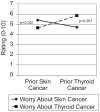Risky feelings: why a 6% risk of cancer does not always feel like 6%
- PMID: 20739135
- PMCID: PMC2993812
- DOI: 10.1016/j.pec.2010.07.041
Risky feelings: why a 6% risk of cancer does not always feel like 6%
Abstract
Objective: Emotion plays a strong role in the perception of risk information but is frequently underemphasized in the decision-making and communication literature. We sought to discuss and put into context several lines of research that have explored the links between emotion and risk perceptions.
Methods: In this article, we provide a focused, "state of the science" review of research revealing the ways that emotion, or affect, influences people's cancer-related decisions. We identify illustrative experimental research studies that demonstrate the role of affect in people's estimates of cancer risk, their decisions between different cancer treatments, their perceptions of the chance of cancer recurrence, and their reactions to different methods of presenting risk information.
Results: These studies show that people have strong affective reactions to cancer risk information and that the way risk information is presented often determines the emotional gist people take away from such communications.
Conclusion: Cancer researchers, educators and oncologists need to be aware that emotions are often more influential in decision making about cancer treatments and prevention behaviors than factual knowledge is.
Practice implications: Anticipating and assessing affective reactions is an essential step in the evaluation and improvement of cancer risk communications.
Copyright © 2010 Elsevier Ireland Ltd. All rights reserved.
Conflict of interest statement
Conflicts of interest – None declared.
Figures
References
-
- National Cancer Institute funds four Eenters of Excellence in Cancer Communications Research. National Cancer Institute; 2003. [September 18, 2009]; Available from: http://cancercontrol.cancer.gov/hcirb/ceccr/CECCR_Awards_Press_Announcem....
-
- Stryker JE, Fishman J, Emmons KM, Viswanath K, Stryker JE, Fishman J, Emmons KM, Viswanath K. Cancer risk communication in mainstream and ethnic newspapers. Prev Chronic Dis [serial on the Internet] 2009. Available from: http://www.cdc.gov/pcd/issues/2009/jan/08_0006.htm. - PMC - PubMed
Publication types
MeSH terms
Grants and funding
LinkOut - more resources
Full Text Sources
Medical


